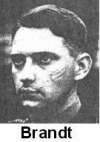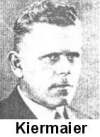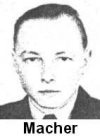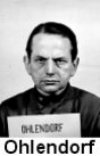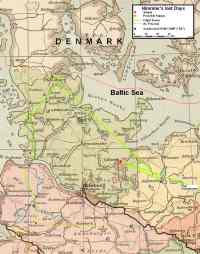 |
| Flight Route |
Being aware of the impending German defeat, Himmler tried to approach the Allies: Hungarian Jews would be released
from KZs in exchange for allied trucks. In
November 1944 he permitted the
transfer of several hundred KZ prisoners to Sweden, ordered the end of the mass murder of Jews, and
proposed surrender on the western front whilst continuing to fight in the East.
From
23 January 1945 Himmler had resided at the private nursing home
of his medical adviser, Prof Dr
Karl Gebhardt in
Hohenlychen, 100 km north of
Berlin.
Advised by SS-General
Walter Schellenberg and encouraged by his masseur,
Felix Kersten, Himmler tried to take up peace negotiations with the Allies
(behind
Hitler's back) via Count
Folke Bernadotte,
deputy chief of the Swedish Red Cross, who was mainly interested in obtaining concessions for Scandinavians in
German KZs. On
22 April 1945 he met the Count in
Hohenlychen, and again on
23/24 April in
Lübeck. As a result 20,000 KZ prisoners were released and brought to Sweden.
On
26 April Himmler moved to
Schwerin,
100 km east of
Hamburg, together with his staff and some of his escort
battalion. There he was near Admiral
Karl Dönitz, the Commander-in Chief
of the German Navy, and the most powerful man in north-west Germany in those days.
Meanwhile Himmler's negotiations had become known and after a related BBC broadcast on
28 April Hitler deprived him of all offices
and ordered Himmler's arrest. On
29 April the Commander-in-Chief of the German
Air Force, General
Ritter von Greim, fled from embattled
Berlin to
Dönitz's new headquarters
in
Plön (60 km north of
Hamburg), and
handed over the arrest order.
Dönitz had no power over Himmler and had
even established his own bodyguard, consisting of submariners, instead of SS guards.
On
30 April Dönitz was appointed
Head of State following
Hitler's suicide on the afternoon of that day.
He told Himmler that he could not join the new government.
Dönitz
didn't like Himmler and his unwanted SS staff in his HQ and finally said to him:
"
Anybody who is a traitor once, is ready to betray a second time."
On
6 May Himmler received a written order dismissing him from all offices.
From that moment on Himmler was no longer Commander-in-Chief of the German Reserve Army, Chief of Police,
and
Reichsführer-SS. The newly appointed Minister of the Interior, Count
Schwerin
von Krosigk, advised Himmler "to drive straight to
Montgomery's HQ
and say that you are Heinrich Himmler and that you want to take full responsibility for everything the SS has done."
From 6 or 7 until 11 May 1945 Himmler and 5 attendants stayed at a farm near
Satrup. Himmler decided to go to Bavaria, joined by a few SS-officers and
perhaps 7 NCOs: His personal assistant Dr
Rudolf Brandt,
probably
SS-Obergruppenführer und Generalleutnant der Waffen-SS Prof Dr
Karl Gebhardt, chief SS surgeon and Himmler's personal medical adviser,
probably
SS-Brigadeführer und Generalmajor der Polizei
Otto Ohlendorf, chief of the RSHA Department III,
SS-Sturmbannführer
Josef Kiermayer, his personal aide and secretary,
SS-Obersturmbannführer
Werner Grothmann,
SS-Sturmbannführer
Heinz Macher, and probably 10 other SS men.
They removed all insignia from their uniforms and placed false documents in their pockets in the expectation that
these would prove that they were recently released NCOs of the
Geheime Feldpolizei. They did not know that
even NCOs of this organization were also on the Allied Wanted List ("Immediate Arrest" category). Himmler’s papers
identified him as "Ex-Sergeant
Heinrich Hitzinger of a Special Armoured Company,
attached to the Secret Field Police, demobilized on
3 May 1945".
On
10 May the group left
Dönitz's
final HQ in
Flensburg and
drove southwards in 4 large cars. On
11 May the group appeared in
Delve, a small village a few kilometres southeast of
Friedrichstadt on the Eider River. On
12 May they
probably abandoned their cars in
Marne, and
decided to continue their way on foot,
towards the Elbe River. In the evening they found a fisherman who ferried them (allegedly for 500 RM) from
Brunsbüttel across the Elbe River to
Neuhaus,
a small town at the mouth of the Oste River, at the south bank of the Elbe River. During the following 5 days the
group slowly moved southwards. On their way they merged into the background as this area, already under British
control, was teeming with German troops of all services.
From this point there are different possibilities re Himmler's route:
1.
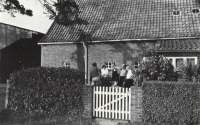 |
| Farmhouse Waldstraße * |
On
18 May the group reached
Bremervörde where
they planned to cross the Oste River. They may have intended to walk through the sparsely inhabited countryside around
the small town of
Bremervörde, between
Hamburg and
Bremen. This provided the
only possibility of avoiding the densely populated areas around
Hamburg and
Lübeck on their way southward.
From 18-22 May the group stayed at a farmhouse on
Waldstraße, without telling the owner their true identity.
From here
Kiermayer investigated the situation at the guarded
Oste River bridge, not knowing that the group could have easily crossed
the river via an unguarded ford some metres upstream. Twice he demanded passes from the district administration in
Bremervörde but
Landrat Dohrmann
refused.
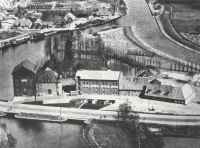 |
| Lohse's Mill * |
When
Kiermayer returned to the farmhouse and reported on the situation, the men
decided to divide the group. The bulk would try to pass the British check-point at the bridge first. At 3 p.m.
Kiermayer and Dr
Gebhardt set off for
the bridge. They intended to come back if there were no problems. One hour later
they arrived at the check-point where they were stopped and taken to Sergeant
Ken Baisbrown, a member of the Intelligence Corps, and on duty at the mill
of
Wilhelm Lohse, which served as an office. The British gave the men the impression
that everything was in order, and they were sent back with 2 British Army lorries and an escort to bring in the rest of
their "sick comrades" (most of whom were purportedly sick policemen on their way to
München (Munich), supervised by Dr
Gebhardt,
who spoke English). Meanwhile
Baisbrown went to the nearby office of the 1003
Field Security Reserve Detachment and told Staff-Sergeant
John Hogg about
these two suspicious men who allegedly belonged to the Secret Field Police GFP (
Geheime Feldpolizei), in
itself a reason for automatic arrest.
After a while
Gebhardt returned to the check-point, but without Himmler
and two others. Sergeant
Arthur Britton detected that all their documents
bore the same GFP stamp, dated after
1 May 1945. In addition, some members
initially denied being part of the group although Dr
Gebhardt claimed that the whole
party was in his care. Therefore the men were segregated.
Britton
and
Baisbrown grilled the youngest and after a short time he admitted that
the GFP stamp was in fact an SD headquarters stamp and that the men belonged together. At 6 p.m. the men were
arrested and brought to the Civil Internment Camp in
Westertimke near
Zeven. Together with
Dr
Gebhardt, Hogg drove back to the farmhouse, since some of the arrested had
expressed concern about three other sick members of their group. Meanwhile Himmler and his two companions had left
the farmhouse.
Now British intelligence personnel had been alerted that three more SD-sponsored policemen were on their way
to an unknown destination.
Because the others obviously had no problems in crossing the check-point, Himmler,
Grothmann, and
Macher hid for a
further day before trying it themselves. On
22 May, walking on
Bremervörde's main road toward the check-point, they were stopped by a
patrol and brought to the office besides the mill.
Arthur Britton received them
at about 5 p.m. They showed their documents but the British were aware that they were forgeries. Corporal
Richard Forrest searched their belongings, then they were probably brought
to a British office at
Dohrmann's bakery, a house on
Bahnhofstraße in
Bremervörde, for
interrogation. Afterwards they were arrested at the mill.
Himmler and his two companions spent the night on the first floor of the mill, sleeping on the grain
(
official report).
2.
Himmler and his two companions were captured on
21 May by 3 Russians (who were
assigned to a British post at the River Oste) in
Meinstedt (20 kilometres south of
Bremervörde, 2 km northeast of
Zeven).
Then they were brought to
Bremervörde where they spent the night in the mill.
3.
From
Bremervörde the men went 6 km southward to the next bridge over
the Oste River, located in
Minstedt.
2.5 km south of
Minstedt the POW Camp
"Stalag XB" was located. This camp was
liberated by the British Army on
29 April 1945. The British opened the gate and the
fence so that the POWs could leave the camp. Therefore hundreds of Russian and Polish POWs crossed out the region
in
April, May, and June 1945. Some of them might have joined the British troops to
look out for their former SS camp guards or soldiers. The British post, reinforced by a tank, could have been
deployed on one of the hills near the river, together with the already mentioned 3 Russians, assigned to the post.
The British brought Himmler and his companions to
Bremervörde.
Be that as it may, Himmler was taken to the Civil Internment Camp in
Westertimke.
At about 7 a.m. next morning, the three GFP suspects were duly driven by
Arthur Britton and two guards in a 15 cwt truck to
Westertimke for initial processing, a journey of some 30 km.
En route, a stop was made at
Zeven to report the arrest of three
SD men to Captain
Excell at 45 Field Security Section HQ. Sergeant
Britton was told to continue to
Westertimke cage
for registration.
The trio spent the greater part of the day - Wednesday
23 May 1945 - being moved about by
British Army transport. During the afternoon, a trip was made (probably via
Fallingbostel on Lüneburg Heath) to 031 Civil Interrogation Camp which had just
moved to
Kolkhagen Camp on the western side of the village of
Barnstedt, south of
Lüneburg.
At 6:30 p.m. on
23 May 1945, "Sergeant
Hitzinger" and
his escorts were booked into
031 CIC Barnstedt. At this time ex-
Gauleiter of
Hamburg,
Karl Kaufmann, a more moderate Nazi,
was watching new arrivals from the inner compound of
Kolkhagen Camp.
He noted an odd figure in military boots and breeches and a civilian jacket and saw him go behind a bush, remove
an eye patch, and reappear putting on glasses - he was immediately recognizable as Himmler, whom
Kaufmann had met. This must have been the moment when Himmler decided to admit
his identity.
At about 7:00 p.m., the camp commandant, Captain
Thomas Selvester, was informed
that three prisoners were insisting on seeing him, in itself an unusual request. Himmler had presumably re-disguised
himself for effect, for when he appeared before the camp commandant, he was again wearing the eye patch.
Selvester thus described the scene:
"
The first man to enter my office was small, ill-looking and shabbily dressed, but he was
immediately followed by two other men (Grothmann and
Macher), both of whom were tall and soldierly-looking, one slim, and one well-built.
The well-built man walked with a limp. I sensed something unusual, and ordered one of my sergeants to place the two men
in close custody, and not to allow anyone to speak to them without my authority. They were then removed from my
office, whereupon the small man, who was wearing a patch over his left eye, removed the patch and put on a pair of
spectacles. His identity was at once obvious, and he said "Heinrich Himmler" in a very quiet voice."
Captain
Selvester immediately informed HQ British Second Army at
Lüneburg and Major
Rice, an
Intelligence staff officer, arrived at 7:30 p.m. to confirm Himmler's identity. The German was asked to sign his
name and this was compared with a signature Major
Rice had brought with him.
The next step was a body search:
"
This I carried out personally," said Captain
Selvester, "
handing each item of clothing as it was
removed to my sergeant, who re-examined
it. In his jacket I found a small brass case, similar to a cartridge case, which contained a small glass phial. I
recognized it for what it was, but asked Himmler what it contained, and he said, 'that is
my medicine. It cures stomach cramp.' I also found a similar brass case, but without the phial, and came
to the conclusion that the phial was hidden somewhere on the prisoner's
person. When all Himmler's clothing had been removed and searched, all the orifices of his body were searched, also his
hair combed and any likely hiding place examined, but no trace of the phial was found. At this stage he was not asked
to open his mouth, as I considered that if the phial was hidden in his mouth and we tried to remove it, it might
precipitate some action that would be regretted. I did however send for thick bread and cheese sandwiches and tea,
which I offered to Himmler, hoping that I would see if he removed anything from his mouth. I watched him closely,
whilst he was eating, but did not notice anything unusual."
On
23 May, Himmler was taken to the Security Force Headquarters at
Uelzener Straße 31a in
Lüneburg.
He had to undress himself and was inspected by the military doctor, Captain
C. J.
Wells, accompanied by Colonel
Michael Murphy (Secret Service), Major
Norman Whittaker, and Company Sergeant Major
Edwin Austin.
When the doctor saw a dark object in a gap in Himmler's lower jaw, he ordered him to come closer to the light and
tried to remove the glass capsule. Suddenly Himmler bit on the cyanide capsule and at the doctor's fingers.
Himmler
fell to the ground (or: he was thrown to the ground) and someone
shouted "
The bastard beats us!" The smell of prussic acid spread through the room.
"
We immediately upended the old bastard and got his mouth into the bowl of water which was
there to wash the poison out", noted Major
Whittaker in his diary.
"
There were terrible groans and grunts coming from the swine." Himmler's tongue was
secured in an attempt to prevent him from swallowing the poison. Dr
Wells tried
resuscitation but it was in vain. After a quarter hour they stopped. "
... it was a losing battle
and this evil thing breathed its last at 23:14 hours." (Winston G. Ramsey: Himmler's Suicide. In: After the
Battle No 14, London 15th August 1976, p. 35)
At least one
death mask of Himmler was taken. On
25 May an
autopsy was conducted, the teeth configuration compared, and the brain and part of his skeleton removed.
In the early morning of
26 May, four men (
Whittaker, Austin,
Weston, and Ottery) brought Himmler's corpse to a forest near
Lüneburg
and buried it.
See the "
Grothmann Protocol"
(
Page 1,
Page 1a,
Page 2,
Page 8,
Page 13)
Photos:
AFTER THE BATTLE Magazine
*
Uwe Ruprecht
Westertimke Map:
www.relikte.com
Sources:
AFTER THE BATTLE Magazine. Issue No 14/1976, and 17/1977. See:
www.afterthebattle.mcmail.com
Uwe Ruprecht:
Das Grab im Wald on:
www.kueste.vvn-bda.de/grab.htm
Gutman, Israel, ed.
Encyclopedia of the Holocaust, Macmillan Publishing Company, New York, 1990
© ARC 2005








